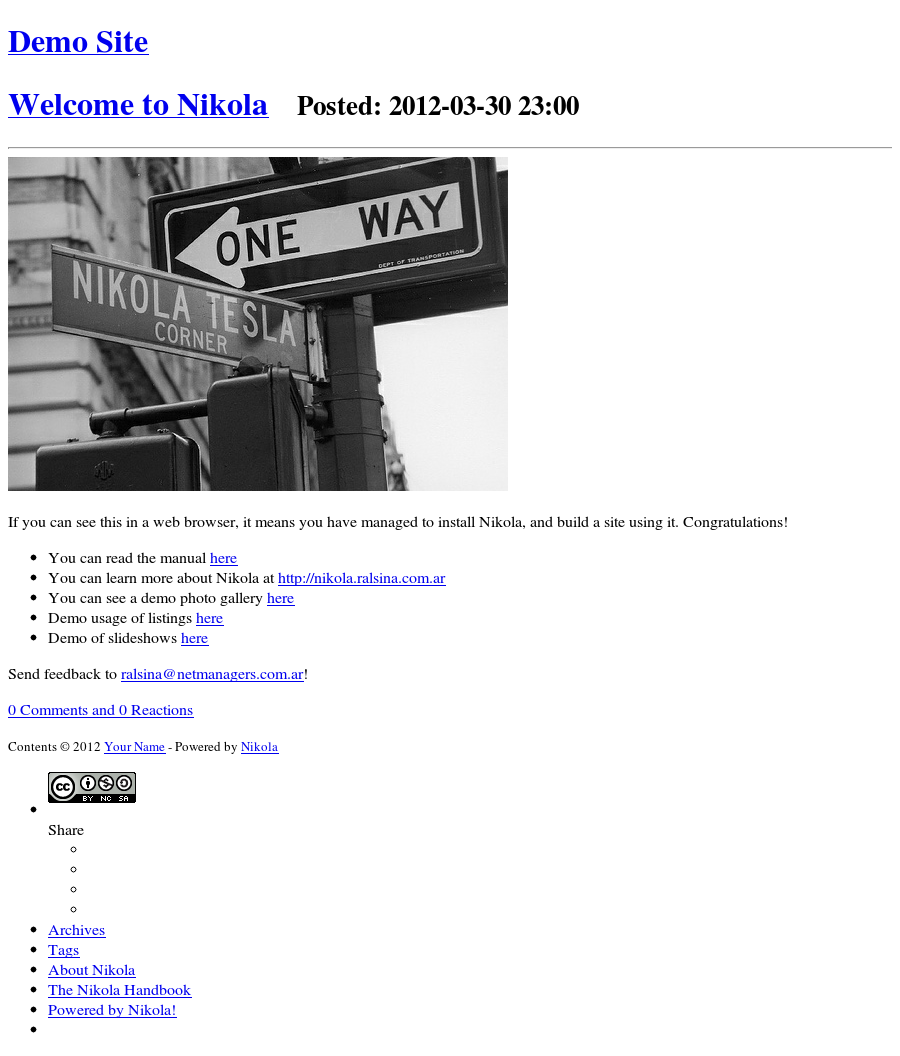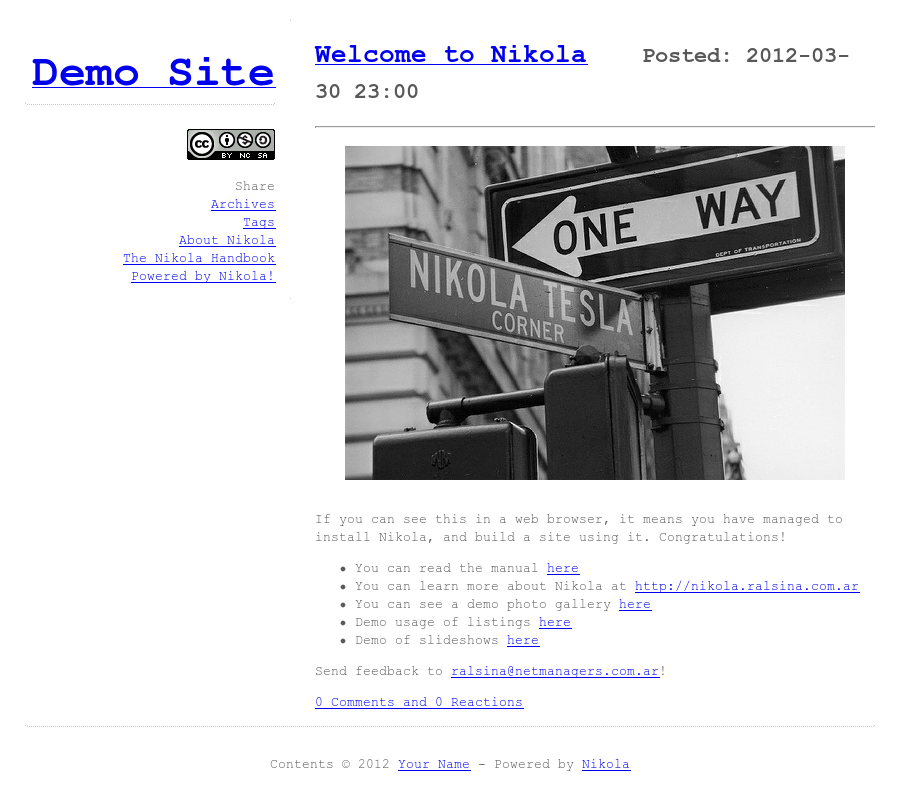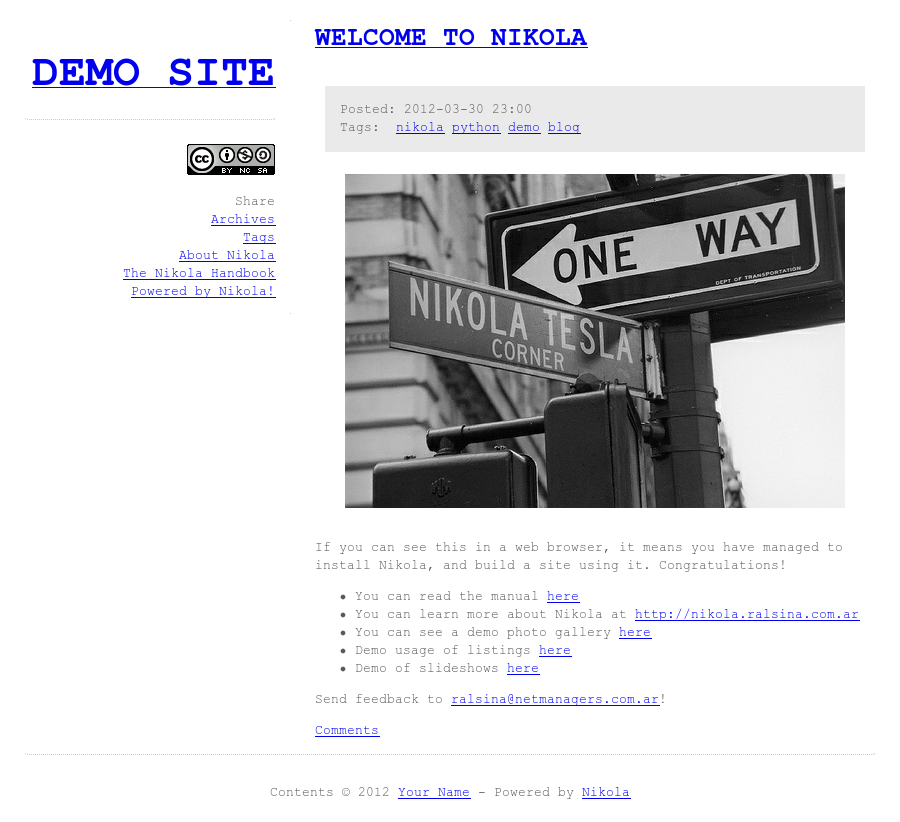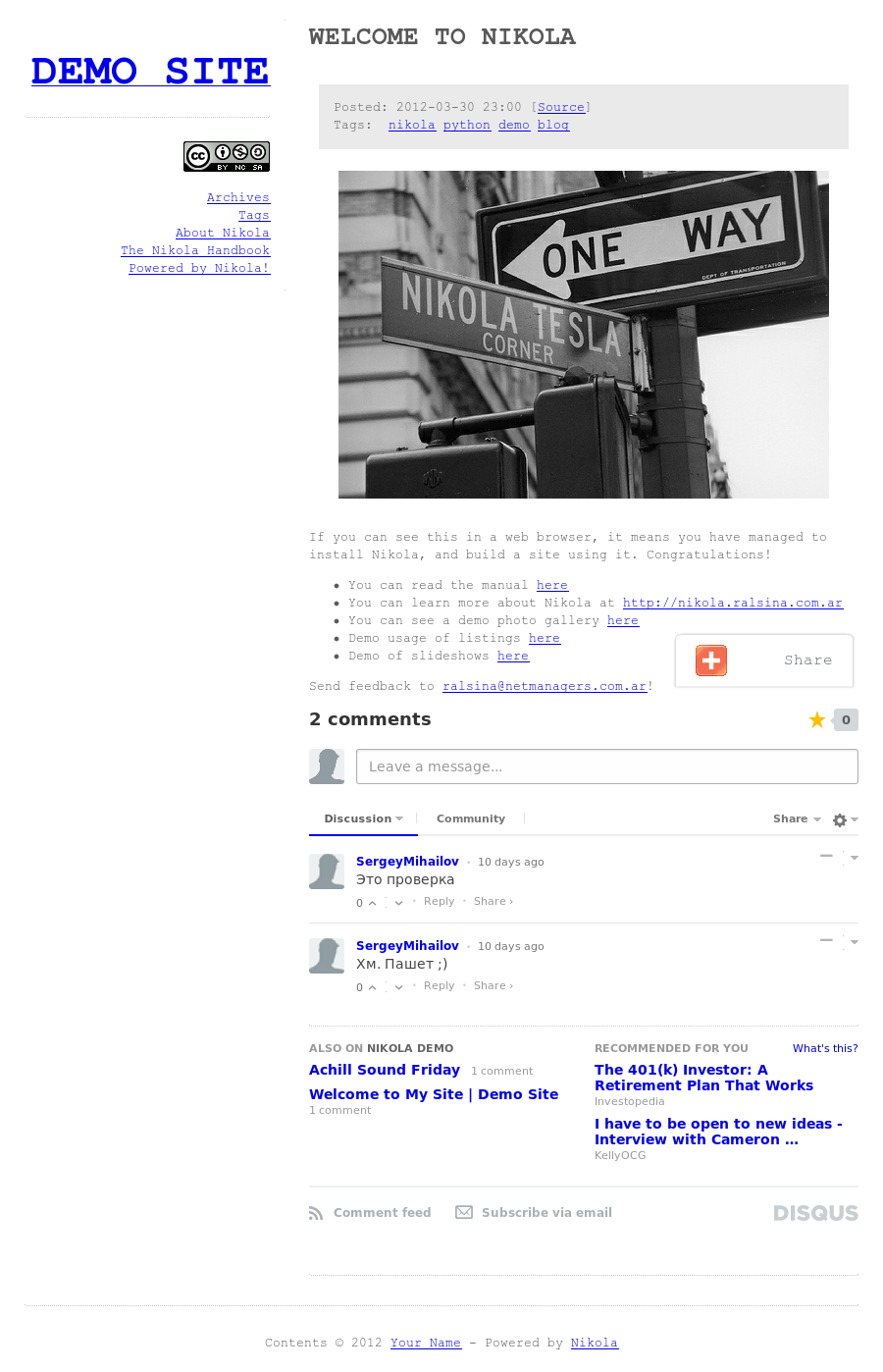Creating a Theme for Nikola From Scratch (almost)
There is some documentation about creating themes for Nikola, but maybe a tutorial is also a useful way to explain it. So, here it is. I'll explain how to create a theme (almost) from scratch. Alternatively, you can take an existing theme and modify only parts of it via inheritance, but that's for another document.
I will try to create a theme that looks like Vinicius Massuchetto's Monospace Theme.
Starting The Theme
First, we create a testing site, and copy the orphan theme from nikola's sources into the right place:
$ nikola init monospace-site A new site with some sample data has been created at monospace-site. See README.txt in that folder for more information. $ cd monospace-site/ $ mkdir themes $ cp -RL ~/Desktop/proyectos/nikola/nikola/nikola/data/themes/orphan/ themes/monospace
The next step is to make the testing site use this new theme, by editing conf.py and
changing the THEME option:
# Name of the theme to use. Themes are located in themes/theme_name THEME = 'monospace'
Now we can already build and test the site:
$ nikola build && nikola serve

This is the almost completely unstyled "orphan" theme.
Of course, the page layout is completely broken. To fix that, we need to get into templates.
Templates: Page Layout
The general page layout for the theme is done by the base.tmpl template, which is done using
Mako. This is orphan's base.tmpl, it's not very big:
## -*- coding: utf-8 -*- <%namespace file="base_helper.tmpl" import="*"/> <!DOCTYPE html> <html lang="${lang}"> <head> ${html_head()} <%block name="extra_head"> </%block> </head> <body> %if add_this_buttons: <script type="text/javascript">var addthis_config={"ui_language":"${lang}"};</script> % endif <h1 id="blog-title"> <a href="${abs_link('/')}" title="${blog_title}">${blog_title}</a> </h1> <%block name="belowtitle"> %if len(translations) > 1: <small> ${(messages[lang][u"Also available in"])}: ${html_translations()} </small> %endif </%block> <%block name="content"></%block> <small>${content_footer}</small> <!--Sidebar content--> <ul class="unstyled"> <li>${license} ${html_social()} ${html_sidebar_links()} <li>${search_form} </ul> ${analytics} <script type="text/javascript">jQuery("a.image-reference").colorbox({rel:"gal",maxWidth:"80%",maxHeight:"80%",scalePhotos:true});</script> </body>
It's basically a HTML document with some placeholders to be replaced with actual content, configuration options, and some helper functions.
For example, the html_head helper can be used to add CSS or JS files in all document's head tags.
Monospace is a two-column-with-footer layout, so let's copy the basics from its HTML and see what happens:
## -*- coding: utf-8 -*- <%namespace file="base_helper.tmpl" import="*"/> <!DOCTYPE html> <html lang="${lang}"> <head> ${html_head()} <%block name="extra_head"> </%block> </head> <body class="home blog"> %if add_this_buttons: <script type="text/javascript">var addthis_config={"ui_language":"${lang}"};</script> % endif <div id="wrap" style="width:850px"> <div id="container" style="width:560px"> <%block name="content"></%block> </div> <div id="sidebar"> <!--Sidebar content--> <h1 id="blog-title"> <a href="${abs_link('/')}" title="${blog_title}">${blog_title}</a> </h1> <%block name="belowtitle"> %if len(translations) > 1: <small> ${(messages[lang][u"Also available in"])}: ${html_translations()} </small> %endif </%block> <ul class="unstyled"> <li>${license} ${html_social()} ${html_sidebar_links()} <li>${search_form} </ul> </div> <div id="footer"> ${content_footer} </div> </div> ${analytics} <script type="text/javascript">jQuery("a.image-reference").colorbox({rel:"gal",maxWidth:"80%",maxHeight:"80%",scalePhotos:true});</script> </body>

Yikes!
This will get better quickly once we add some CSS
Base CSS
The orphan theme includes just a little styling, specifically rest.css so
the restructured text output looks reasonable, and code.css for code snippets.
It also includes an empty assets/css/theme.css where you can add your own CSS.
For example, this is taken from the original monospace theme:
body { margin:0px; padding:20px 0px; text-align:center; font-family:Monospace; color:#585858; } .post { margin:0px 0px 30px 0px; padding:0px 0px 30px 0px; border-bottom:1px dotted #C8C8C8; } .meta { margin:10px; padding:15px; background:#EAEAEA; clear:both; } #footer { text-align:center; clear:both; margin:30px 0px 0px 0px; padding:30px 0px 0px 0px; border-top:1px dotted #C8C8C8; } #wrap { margin:0px auto; text-align:left; font-size: 13px; line-height: 1.4; } #container { float:right; } #sidebar { overflow:hidden; clear:left; text-align:right; width:250px; height:auto; padding:0px 15px 0px 0px; border-right:1px dotted #C8C8C8; } #sidebar li { list-style-type:none; } #sidebar > li { margin:20px 0px; } #sidebar h1 { border-bottom:1px dotted #C8C8C8; } #sidebar .description { display:block; width:100%; height:auto; margin:0px 0px 10px 0px; } h1, h2, h3, h4, h5, h6, h7 { margin:0px; text-transform:uppercase; } h4, h5, h6 { font-size:14px; } h1 { padding:0px 0px 15px; margin:0px 0px 15px 0px; }
This will (after we rebuild it) make the site looks different of course, and getting closer to our goal:

Monospaced allright.
If you compare it to the original, however, you will see that the layout of
the posts themselves is different, and that was not described in base.tmpl at all. But if you look, you'll see that
there is a placeholder called content: <%block name="content"></%block>
That's because base.tmpl defines the base layout. The layout of more specific pages, like "the page that shows
a lis of posts" is defined in the other templates. Specifically, this is defined in index.tmpl:
## -*- coding: utf-8 -*- <%namespace name="helper" file="index_helper.tmpl"/> <%inherit file="base.tmpl"/> <%block name="content"> % for post in posts: <div class="post"> <h1><a href="${post.permalink(lang)}">${post.title(lang)}</a> <small> ${messages[lang]["Posted"]}: ${post.date.strftime(date_format)} </small></h1> <hr> ${post.text(lang, index_teasers)} ${helper.html_disqus_link(post)} </div> % endfor ${helper.html_pager()} ${helper.html_disqus_script()} </%block>
So, let's tweak that to be closer to the original. We put the post's metadata in a box, add links for the posts tags, move the date there, etc.
## -*- coding: utf-8 -*- <%namespace name="helper" file="index_helper.tmpl"/> <%inherit file="base.tmpl"/> <%block name="content"> % for post in posts: <div class="postbox"> <h1><a href="${post.permalink(lang)}">${post.title(lang)}</a></h1> <div class="meta" style="background-color: rgb(234, 234, 234); "> <span class="authordate"> ${messages[lang]["Posted"]}: ${post.date.strftime(date_format)} </span> <br> <span class="tags">Tags: %if post.tags: %for tag in post.tags: <a class="tag" href="${_link('tag', tag, lang)}"><span class="badge badge-info">${tag}</span></a> %endfor %endif </span> </div> ${post.text(lang, index_teasers)} ${helper.html_disqus_link(post)} </div> % endfor ${helper.html_pager()}

Close enough!
Then if we click on the post title, we will see some broken details in the metadata that can be fixed in post.tmpl, and so on.
## -*- coding: utf-8 -*- <%namespace name="helper" file="post_helper.tmpl"/> <%inherit file="base.tmpl"/> <%block name="content"> <div class="post"> ${helper.html_title()} <div class="meta" style="background-color: rgb(234, 234, 234); "> <span class="authordate"> ${messages[lang]["Posted"]}: ${post.date.strftime(date_format)} [<a href="${post.pagenames[lang]+'.txt'}">${messages[lang]["Source"]}</a>] </span> <br> %if post.tags: <span class="tags">${messages[lang]["Tags"]}: %for tag in post.tags: <a class="tag" href="${_link('tag', tag, lang)}"><span class="badge badge-info">${tag}</span></a> %endfor </span> <br> %endif <span class="authordate"> ${helper.html_translations(post)} </span> </div> ${post.text(lang)} ${helper.html_pager(post)} ${helper.html_disqus(post)} </div> </%block>

Details, details.
The demo site exercises most of the features in Nikola, so if you make it look good, your site probably will look good too. This monospace theme is in nikola's github master, if you want to use it or play with it.
Is it responsive?
No, it's just a very basic theme.
> /nikola/nikola/nikola/
Mind explaining your directory structure?
There is a projects folder (~/Desktop/proyectos) then there is a folder "nikola", where I have all nikola branches and releases and random things, then the master checkout is called "nikola" because that's what happens if you do what github says to checkout, then inside it there is a "nikola" folder because the python package is called that. Thus "nikola/nikola/nikola"
I could change it to nikola/master/nikola but there are a bunch of scripts that do things like pulling the docs into the website when I do a release and it would be more annoying to have to edit those.